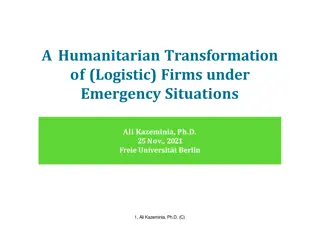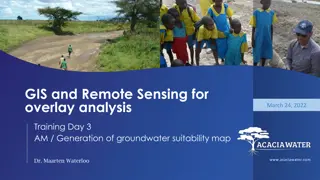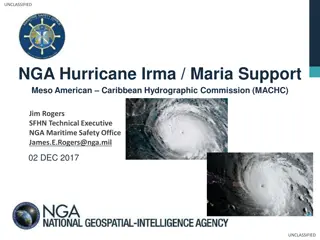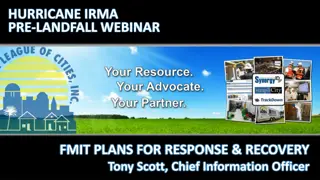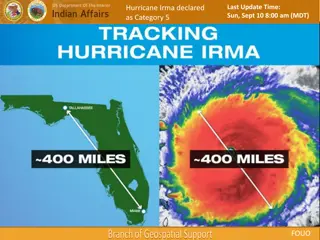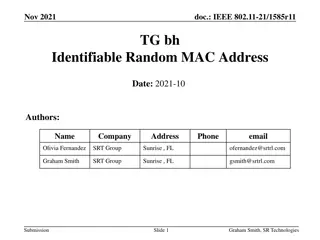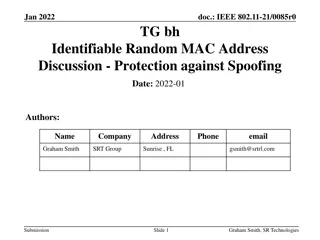
Developing Strategies for Fair Company Taxation in Developing Countries
Exploring the challenges faced by developing countries in generating tax revenue, this article delves into potential approaches to balance investment attraction and sustainable revenue mobilization through international company taxation developments. Addressing issues like low tax-to-GDP ratios, donor dependencies, and narrow revenue bases, the focus is on propelling nation-building aspirations.
Download Presentation

Please find below an Image/Link to download the presentation.
The content on the website is provided AS IS for your information and personal use only. It may not be sold, licensed, or shared on other websites without obtaining consent from the author. If you encounter any issues during the download, it is possible that the publisher has removed the file from their server.
You are allowed to download the files provided on this website for personal or commercial use, subject to the condition that they are used lawfully. All files are the property of their respective owners.
The content on the website is provided AS IS for your information and personal use only. It may not be sold, licensed, or shared on other websites without obtaining consent from the author.
E N D
Presentation Transcript
Brengt Pijler 2 (GLOBE) een eerlijk verdeling van belasting voor ontwikkelingslanden? 1 Vereniging voor Belastingwetenschap 2022
Todays topic: International company tax developments and some reflections on ways forward for developing countries 2
1. Introduction A reflection on international developments in company taxation from the perspectives of developing countries. Proposing some suggestions for potential tax policy approaches for the developing world, based on securing two objectives: (i) maintain and/or attract investment while (ii) devising ways and means to further securing sustainable revenue mobilization policies. 3
1. Introduction (contd) The first objective could be pursued by prudently continuing to compete for investment to the extent possible considering the available scope for such under the envisaged Pillar Two approach and on a regionally coordinated basis. Meeting the second objective could occur by furthering the market-based tax base division agenda that has emerged in recent years along with the spread of digital services taxes and in the context of developments towards the construction of the Amount A concept in Pillar One. Such a policy direction could also be pursued if the envisaged Pillars were to collapse (which may depend on US/EU approval) 4
2. Company taxation in the developing world; challenges Addressing the issues that arise in these countries in their attempts to effectively raise much needed tax revenue to help finance their nation-building aspirations. Revenue mobilization is key to sustainable development and growth in any country and region. Typical challenges that developing countries encounter in this regard involve: Relatively low tax-to-GDP ratios (grosso modo 10-20%), Dependencies on aid and (soft) loans (donor dependencies), Budget deficits, Limited revenue collection capacities, Tax gaps (relatively large informal sectors; grosso modo 40%), A relatively heavy reliance on distortive corporate income taxes, Narrow revenue bases, and ensuing tax planning and tax competition issues. 5
2. Company taxation in the developing world; challenges (cont d) Particularly in company taxation: The objective of tax competition responses appears to be predominantly to compete for investment in routine functions such as production, mining and extraction, manufacturing, and assembly of finalized and semi-finalized products that are often exports. At the same time, demographic developments and economic growth create even larger market potentials, particularly in the currently digitalizing world and considering the growth in internet use on mobile devices. This affords a number of opportunities for self-empowerment and also consolidating revenue mobilization potentials 6
2. Company taxation in the developing world; challenges (cont d) Like any country, including those in the developed world, are impacted by ensued capacity issues. This is applicable already on top of the distortive properties embedded in company tax systems involving financing decisions (debt equity bias) and investment location decisions (supply side tax base division). 7
3. BEPS Projects; whats in it for low-income countries? E.g., Low-Income Countries may not be able to realize particular areas of interest in the BEPS agenda. Due to a number of issues, which range from limited technical expertise on BEPS related issues, lack of a common agenda, and low participation in the inclusive framework. Twenty-five (25) out of one hundred and thirty-seven (137) IF BEPS Countries are African States. Limited resources i.e. tax administration staff dealing with BEPS and also other important domestic tax issues. The BEPS agenda, may therefore fail to deliver a framework that is orientated to Lower Income Tax Countries issues. E.g. Pillar 2: Attention to the role of tax incentives, % minimum tax rate instead of attention to implementation (of complex) model rules. 8
3. BEPS Projects; whats in it for low-income countries? (cont d) What did the 2015 BEPS 1.0 initiative bring to the developing world? We have seen the OECD-managed technical assistance under the Tax Inspectors Without Borders capacity building initiative. Discussions in literature on the project s merits for the developing world, among others, for instance, in view of the BEPS Inclusive Framework that has been set up to legitimize and secure a global implementation of the BEPS 2015 outcomes rather than establishing a globally endorsed company tax policy. capturing the over-arching issue that ...international organisations and tax scholars have concerns regarding whether all BEPS Actions are relevant for developing countries, legitimacy deficits, and on the feasibility of implementing BEPS Actions in developing countries 9
3. BEPS Projects; whats in it for low-income countries? (cont d) What did the 2015 BEPS 1.0 initiative bring to the developing world? (cont d) The BEPS initiative refers to the concept of taxation at the location of value creation. The supply-side oriented tax base distribution system under the post-BEPS transfer pricing paradigm, however, allots the tax base predominantly to those countries in which the firm s functions that are performed are of a non-routine nature rather than routine with the former being considered to create the greater amount of value. In addition, the objective of the anti-treaty shopping approaches implemented under the BEPS initiative seems to be addressing tax-induced inter-positioning of shell companies while the presence of economic substance functions performed in transfer pricing terminology in the respective hub jurisdiction abroad appears to subsequently require the developing world to waive their source taxing rights. Moreover, the 2015 BEPS initiative does not address those issues involving the company tax base s elasticity in relation to non-scarce routine activity and the incentives these generate for the developing world to mutually compete for investment in production activities, manufacturing activities, and natural resource extraction activities via tax incentive regimes. The BEPS initiative also does not discuss issues involving capital gains tax avoidance. 10
3. BEPS Projects; whats in it for low-income countries? (cont d) What does the 2020 BEPS 2.0 initiative bring to the developing world? Pillar One envisages tax base redivision towards market jurisdictions and user jurisdictions for, basically, the top 100 largest companies worldwide, i.e. away from the supply-side oriented transfer pricing paradigm currently in place to a demand- side oriented, destination based it seems, formulaic tax based redivision approach in company taxation. There is also much uncertainty, though, from the location of taxation under the envisaged new nexus, apportionment rules, and the double tax relief system to the political willingness when ultimately actually changing the company tax paradigm. In the meanwhile, there is pressure to rollback any digital services taxes put in place in countries on a unilateral basis. It remains to be seen where we will end-up there and whether this will eventually improve the positions of developing countries. 11
3. BEPS Projects; whats in it for low-income countries? (cont d) What does the 2020 BEPS 2.0 initiative bring to the developing world? (cont d) Pillar Two envisages establishing a set limit in country tax competition possibilities by putting in multilaterally agreed limitations on them via a minimum company tax rate of 15% and top-up taxation to the minimum in the multinational firm s home country (which are generally developed countries), i.e. to the extent that other countries do not adhere to the new minimum tax paradigm. Again, there is much uncertainty, though, from the prospect of how the global Pillar Two system will interplay with company tax systems worldwide, for instance, regarding the question of whether the tax treaties in place will actually allow for an effectuation of the top-up taxation system. Moreover, it seems that the envisaged two-Pillar system will be rather complex to administer, which is something that also does not appear to be particularly helpful considering matters from the perspective of the capacity-scarce realities in a typical developing country s revenue administration. 12
3. BEPS Projects; whats in it for low-income countries? (cont d) What does the 2020 BEPS 2.0 initiative bring to the developing world? (cont d) In addition, one may ask whether the envisaged mandatory dispute settlement mechanisms via binding arbitration processes would ultimately effectively consider the needs of the developing world. It should be noted in this context that some issues in this regard may be observed, for instance, in relation to developing country representation in any envisaged arbitration bodies and any succeeding sovereignty matters. This is particularly valid considering some potentially involved surrendering or circumventing of roles for national court systems to adjudicate disputes in this area. These matters formed reasons for Nigeria and Kenya, vocal African countries within the Inclusive Framework, we understand, to not subscribe to the political commitment on the envisaged two pillar approach. 13
4. Which way to go? It is paramount to enhance the effectiveness of the revenue administrations of low-income countries Engaging in further investment in capacity building and human resource development Furthering the enhancement of the robustness of low-income countries company tax systems, Engaging in treaty negotiations and entering into any bilateral or multilateral tax treaties should be approached only after careful and due consideration. 14
4. Which way to go? (contd) Of what relevance is the BEPS 2.0 political agreements of 1 July 2021 and 8 October 2021 and the discussions concerning the digital services taxes Discussion a global holistic solution under the BEPS Inclusive Framework may prove more effective in the long run, however at present, DSTs may be the only solution to temporarily prevent haemorrhaging of much needed revenue which is derived from digital business activities arising from African States Something worthwhile to consider in this regard is joining forces, i.e. regional collaboration. 15
4. Which way to go? (contd) Of what relevance is the BEPS 2.0 political agreements of 1 July 2021 and 8 October 2021 and the discussions concerning the digital services taxes Discussion Regional multilateralism in tax matters might ease tax competition pressures in relation to routine investment directed into the continent Under such a regional coordination of tax incentive regimes, any effective tax rate coordination would pushback regional spillover effects. 16
4. Which way to go? (contd) Concerning policy approaches in relation to Pillars One and Two and the digital services taxes alternative, our intuition would be to introduce a combined tax policy approach in the following manner. The objective to be secured in this context would be to: (i) maintain and/or attract FDI influx while (ii) devising ways and means to further securing sustainable revenue mobilization policies. The first objective could be pursued by prudently continuing to compete for investment to the extent possible, however, on a regionally coordinated basis. The second objective could be addressed by furthering the market-based tax base division agenda that has emerged in recent years along with the spread of digital services taxes and in consideration of developments towards the construction of the Amount A concept in Pillar One and, of course, transparency. Transparency, information sharing, and international mutual administrative assistance, for instance, in transfer pricing, are key, and having a crucial role to play in helping African governments stem illicit financial flows and increase domestic revenue mobilisation 17
4. Which way to go? (contd) Ad (i). The first objective of attracting and maintaining domestic investment could perhaps be achieved via optimal utilization of the scope and opportunity available in the Pillar Two system under the formulaic substance carve out and the de minimis exception to continue competing for investment via incentive regimes, though prudently and on a coordinated regional basis. A worthwhile approach to be taken here could and perhaps should be on a region-wide collaborative basis whereby the developing countries involved gradually and jointly rollback their incentive regimes in a coordinated and prudent manner towards the meeting of the global minimum tax rate under Pillar Two. The process embarked upon would need to be in alignment with the transition period granted under the statement of 8 October 2021 to secure that revenue stream flows to the respective country rather than the multinational firm s home country under the envisaged income inclusion rule under Pillar Two. 18
4. Which way to go? (contd) In relation to the subject to tax rule in the political agreement, however, our suggestion would be to approach the envisaged rule with some due consideration and even restraint perhaps in view of preserving the securing of source taxing rights. The minimum tax under the subject to tax rule refers to an adjusted statutory rate of 9%. Many countries have already adopted these while a question would perhaps be how to fit the conduit company in a jurisdiction that taxes an arm s length spread at a headline rate above 9%. Chances are that any source tax eligibility would need to be waived in such cases under a subject to tax rule. It would perhaps better fit developing countries needs to consolidate source taxation rights as much as possible, i.e. without subject to tax limitations, and expand source taxation eligibility under the treaty equivalents of, for instance, Article 12a and 12b UN Model Tax Convention in a manner similar to the observations made under ad (ii) below. Such an approach would disincentivize outbound profit repatriation c.q. incentivise reinvestment in the respective countries territories that are involved. Our suggestion would also be to focus but with due consideration on Amount B in Pillar One, i.e. the transfer pricing safe harbour for marketing and distribution activities. An exogenous fixed taxable return instead of a required resorting to endogenous transfer pricing analyses is indeed advantageous, particularly in terms of the administrative ease that is obtained. Such types of activities, however, in any event, would still be of a routine nature and accordingly produce likewise revenue influxes under the transfer pricing paradigm whether based on a fixed return or not. 19
4. Which way to go? (contd) Ad (ii). The second objective, revenue mobilization, could perhaps be achieved via a savvy utilization of those destination-based elements that we have seen emerging in company taxation in recent years. Regarding Pillar One, Amount A, matters revolve around assigning a tax base to user and market jurisdictions. It would be in the interest of developing countries to possibly monitor how the design of nexus and apportionment rules evolve, particularly in view of promoting the adoption of both B2B-customer based, B2C-end-customer based, and user-based tax base distribution mechanisms, for instance, also in view of the noted growth in internet uses on mobile devices, among others. Our suggestion in this latter regard would be to focus on tax base distribution keys devised by reference to users numbers, advertisement views, etc., i.e. numbers rather than, for instance, concepts that would refer to value added per user concepts . Additionally, focus could be placed on a policy for lowering thresholds, such what was seen by the ATAF proposal in mid-2021. In the transition stage, it would be worthwhile for those countries that have adopted digital levies and similar unilateral measures to maintain a commitment to these taxes. That is again like what the ATAF has proposed and as Kenya and Nigeria, for instance, have introduced. This stated, it should be noted that the African countries that are Inclusive Framework members and joined the statement of 8 October 2021 have now committed not to newly enact any digital services taxes or any other similar measures, at least for the time being. 20
4. Which way to go? (contd) A relevant aspect of these digital levies is that they seem to fall outside the scope of operation of the double tax conventions and, with that, create some opportunity for manoeuvring and political swaying as a corollary. From this perspective, it may be worthwhile for developing countries operating digital levies to consider adopting a rollback workstream only up to the extent that user and market-based taxation under Amount A is secured in a balanced manner in revenue terms, i.e. under the envisaged multilateral Pillar One convention. A next step could include a collaborative commitment to a global formulaic tax base division approach with a significant role for a destination-based sales factor. A group of developing countries has already proposed this in the advent of the update of 8 October 2021 of the Inclusive Framework political agreement of 1 July 2021. Currently, it may not be a politically opportune moment for formula apportionment when international tax politics appear to be to the contrary. Momentum, however, could perhaps change in the future and this may not be that unlikely when the European Commission begins pushing forward its BEFIT (Business in Europe: Framework for Income Taxation) initiative in 2023 which is effectively a formulary approach for company taxation in the internal market drawn from the CCCTB (Common Consolidated Corporate Tax) proposals of 2011 and 2016. The developing world, for instance, could utilize any such momentum created in the European context to also propose a formulaic approach towards company taxation in developing countries. In that way, the developing world could position itself towards a global destination based, production factor neutral company tax model in the potential end game of global corporate tax reform. 21
4. Which way to go? (contd) What if the Pillars do not survive, collapse, and never achieve fruition? Then developing countries could also perhaps continue in the direction as set forth above. Should Pillar One collapse, developing countries could quite well continue pursuing a path chosen of utilizing any destination-based elements in their company tax systems. In such a scenario, any digital services taxes opportunities will once again become an option that could subsequently be further pursued on a regionally coordinated basis, for instance, under the auspices of the ATAF to secure non-fragmentation of such levies in Africa. The same, for that matter, is valid for the pursuit of expanding source taxation eligibility, c.q. securing any non-waiving of taxing rights under these countries treaty networks. Source taxes, notably, intrinsically also embed some destination-based elements as these assign tax bases to specific market jurisdictions. For the longer-term, the formula alternative as mentioned above may remain a tax policy that is destined to be finalized. 22
4. Which way to go? (contd) What if the Pillars do not survive, collapse, and never achieve fruition? Then developing countries could also perhaps continue in the direction as set forth above. Should Pillar Two collapse, developing countries could quite well continue the paths they have chosen, i.e. to regionally collaborate in addressing tax competition by gradually and jointly rolling back their incentive regimes in a coordinated and prudent way. Another option is to mutually coordinate any of those regimes in terms of effective tax rates employed while affording a margin of freedom regarding the eligibility tests and gateway criteria that are involved. In such a manner, developing countries could perhaps continue investing in ways to stabilize their company tax systems and further build and devise means to further securing sustainable revenue mobilization policies in company taxation. 23
5. Closing comments With a view to submitting suggestions that could cater to the needs and revenue mobilization interests of developing countries Proposing some suggestions for potential tax policy approaches for the developing world, based on securing two objectives: (i) maintain and/or attract investment while (ii) devising ways and means to further securing sustainable revenue mobilization policies. The first objective could be pursued by prudently continuing to compete for investment to the extent possible considering the available scope for such under the envisaged Pillar Two approach and on a regionally coordinated basis. Meeting the second objective could occur by furthering the market-based tax base division agenda that has emerged in recent years along with the spread of digital services taxes and in the context of developments towards the construction of the Amount A concept in Pillar One. Such a policy direction could also be pursued if the envisaged Pillars were to collapse. 24
5. Closing comments Irma Mosquera (Leiden University, ERC Funded Project GLOBTAXGOV, EU Jean Monnet Chair EUTAXGOV): i.j.mosquera.valderrama@law.leidenuniv.nl https://globtaxgov.weblog.leidenuniv.nl/ Maarten de Wilde (AEPICAB, EUR, PwC): dewilde@law.eur.nl https://papers.ssrn.com/sol3/results.cfm 25



